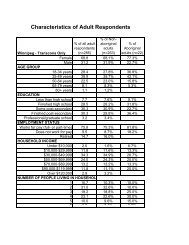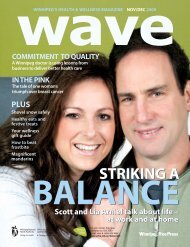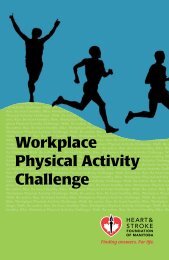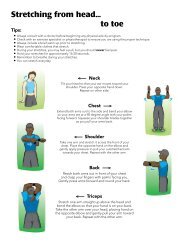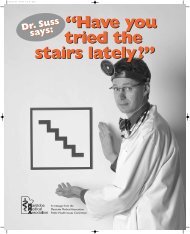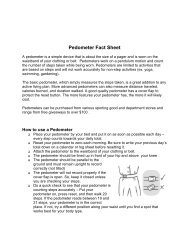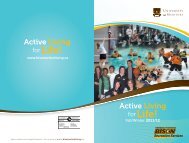Wave: March / April 2010 - Winnipeg in motion
Wave: March / April 2010 - Winnipeg in motion
Wave: March / April 2010 - Winnipeg in motion
You also want an ePaper? Increase the reach of your titles
YUMPU automatically turns print PDFs into web optimized ePapers that Google loves.
Now hear this this<br />
One <strong>in</strong> 10 Canadians suffers from some type of hear<strong>in</strong>g loss.<br />
While hear<strong>in</strong>g loss can occur with age, Dr. Brian Blakley, an<br />
otolaryngologist with the <strong>W<strong>in</strong>nipeg</strong> Health Region, says as<br />
much as 50 per cent of all hear<strong>in</strong>g loss can be prevented.<br />
The most obvious way to prevent hear<strong>in</strong>g loss is to avoid<br />
constant exposure to loud noise. Wear<strong>in</strong>g protective hear<strong>in</strong>g<br />
gear on a construction or <strong>in</strong>dustrial site, or listen<strong>in</strong>g to music<br />
at reasonable volume are two examples of how the risk of<br />
hear<strong>in</strong>g loss can be reduced.<br />
It’s also important to pay attention to possible signs of pend<strong>in</strong>g<br />
hear<strong>in</strong>g problems. Recurr<strong>in</strong>g ear <strong>in</strong>fections, for example,<br />
can lead to hear<strong>in</strong>g loss over time. Children with ear <strong>in</strong>fections<br />
should be taken to a doctor. Adults should consult a<br />
physician to see if their recurr<strong>in</strong>g ear <strong>in</strong>fections are a sign of<br />
possible hear<strong>in</strong>g loss, says Blakley.<br />
The four ma<strong>in</strong> types of hear<strong>in</strong>g loss are:<br />
Presbycusis (progressive loss of hear<strong>in</strong>g)<br />
Presbycusis, or sensor<strong>in</strong>eural hear<strong>in</strong>g loss, is a gradual decl<strong>in</strong>e<br />
<strong>in</strong> sound reception that occurs as you get older. This happens<br />
because the eardrum loses its elasticity and the bones<br />
of the ear become stiffer. Sounds, particularly higher tones,<br />
are muffled. Words are hard to understand if there is a lot<br />
of background noise. At the same time, loud noise may be<br />
pa<strong>in</strong>ful. People with presbycusis should ask others to speak<br />
slowly and clearly. Hear<strong>in</strong>g aids can be very helpful.<br />
Conductive deafness<br />
Conductive deafness is when sound waves are blocked as<br />
they pass through the ear. People with conductive deafness<br />
hear sounds from outside as muffled, but their own voice<br />
may seem louder than normal. Because of this, they often<br />
speak softly. The most common cause of conductive deafness<br />
is earwax. Removal of the wax, after first soften<strong>in</strong>g it, will<br />
make a lot of difference. Other causes of conductive deafness<br />
<strong>in</strong> older people <strong>in</strong>clude ear <strong>in</strong>fections, a tear or hole <strong>in</strong><br />
the eardrum, and damage to the small bones <strong>in</strong> the <strong>in</strong>ner<br />
ear that conduct sound waves. Ma<strong>in</strong> causes <strong>in</strong>clude earwax<br />
<strong>in</strong> the middle ear, otitis media (ear <strong>in</strong>fections), and otosclerosis<br />
(a bone disorder that impairs vibration of the ossicles).<br />
Central deafness<br />
Central deafness can also affect older people, although it is<br />
far less common than either presbycusis or conduction deafness.<br />
Central deafness is due to a problem with<strong>in</strong> the hear<strong>in</strong>g<br />
centres <strong>in</strong> the bra<strong>in</strong>. Sounds can be heard, but language<br />
cannot be understood. Central deafness may follow a long<br />
illness with high fever, long exposure to loud noise, head<br />
<strong>in</strong>juries, stroke, tumors, and certa<strong>in</strong> drugs. The deafness is permanent,<br />
but speech therapy may help communication.<br />
Otosclerosis<br />
Otosclerosis is a disorder of the bone around the <strong>in</strong>ner ear.<br />
Another term for this disorder is otospongiosis, which means<br />
spongy bone. This disorder often occurs <strong>in</strong> the bones between<br />
the middle and the <strong>in</strong>ner ear. Many people are unaware<br />
they have otosclerosis. When it affects the <strong>in</strong>ner ear,<br />
deafness and dizz<strong>in</strong>ess may result. One or both ears may be<br />
affected. It is almost always accompanied by r<strong>in</strong>g<strong>in</strong>g <strong>in</strong> the<br />
ear, which is called t<strong>in</strong>nitus. Unlike some causes of hear<strong>in</strong>g<br />
loss, a hear<strong>in</strong>g loss caused by otosclerosis can be treated.<br />
Treatment <strong>in</strong>cludes surgery to stabilize or replace the small<br />
bones of the <strong>in</strong>ner ear. Surgery can usually return hear<strong>in</strong>g to<br />
a normal or near-normal status. If surgery is not possible, a<br />
hear<strong>in</strong>g aid may be helpful.<br />
“I remember th<strong>in</strong>k<strong>in</strong>g, ‘How true is<br />
that?’” It came as a bolt from the blue for<br />
Slykerman, mak<strong>in</strong>g clear that while she<br />
may have felt terribly alone, she was <strong>in</strong> fact<br />
not. So she called the chairman <strong>in</strong> October<br />
of 2008 and asked if she could sit on the<br />
board. The answer was yes.<br />
Her <strong>in</strong>volvement became a tre-<br />
mendous educational experience.<br />
“They’re an amaz<strong>in</strong>g group<br />
of people,” she says. “I<br />
learned th<strong>in</strong>gs about my<br />
disability, about how<br />
commonplace it is.<br />
As a nurse, I felt<br />
embarrassed,<br />
because I felt like I should have known<br />
these th<strong>in</strong>gs.”<br />
These life-alter<strong>in</strong>g experiences – attend<strong>in</strong>g<br />
university and becom<strong>in</strong>g <strong>in</strong>volved with<br />
the Canadian Hard of Hear<strong>in</strong>g Association<br />
– prompted her to aga<strong>in</strong> seek a solution<br />
to her problem. And that led her back to<br />
Blakley <strong>in</strong> February 2009.<br />
“There’s got to be someth<strong>in</strong>g you can<br />
do,” she told him. As it turned out, there<br />
was.<br />
Blakley suggested that Slykerman<br />
consider the Vibrant Soundbridge. It was<br />
the first time Slykerman had heard of the<br />
device, but she was game. “I needed to<br />
try,” she says. “I just needed to hear.”<br />
Starra Slykerman says be<strong>in</strong>g able to hear clearly has changed her life.<br />
34 WAVE




